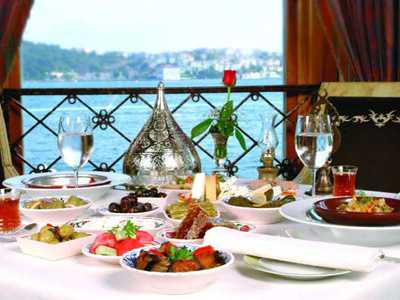By A. Craig Copetas
Bloomberg News
 ISTANBUL — Ottoman Empire chef Ugur Alparslan spends more time in the library than he does in the kitchen.
ISTANBUL — Ottoman Empire chef Ugur Alparslan spends more time in the library than he does in the kitchen.
“These are the lost recipes,” Alparslan says as the sun sets over the Golden Horn and the tables at his Tugra restaurant in the Ciragan Palace Kempinski hotel on Istanbul’s shore begin to fill with 21st-century merchants seeking the missing tastes and aromas of imperial Ottoman Constantinople.
For Alparslan, 49, his ancient menu is as real today as the many portraits of Sultan Mehmed II, who in 1453 conquered Byzantium. The House of Osman, or Ottoman Dynasty, shaped the city on the Bosphorus into the first headquarters for what would become the luxury-goods industry.
Occidental trumpery merchants assigned to the Ottoman court often compared meals at the sultan’s Topkapi palace and elsewhere in the city to those served at Belshazzar’s Babylonian feast. Back in Europe, their reports were at first digested with a pinch of salt, until the 19th-century French chef Alexis Soyer traveled to Constantinople during the Crimean War for a taste of the empire’s Balkan-Caucasus-Persian-Arab-Levant-Mediterranean fusion cooking.
“For me, delicious and lavish food was the epicenter of the Ottoman Empire,” Alparslan says, unveiling a $27.10 grilled winter-celery appetizer decorated with beans, gingered olive oil and tarragon sauce. Yet the chef laments as another choice, a $28 saffron ravioli stuffed with flakes of sun-dried chili and thyme sauce, slides off the serving spoon.
“The sultans did not embrace the printing press,” he says. “So I continually search old handwritten manuscripts to find promising new dishes from the past. I see my job as illuminating history through food.”
Sifting through 493 years of Ottoman culinary chronicles isn’t for the meek. The sultans only ate off of gold, silver or green celadon plates that alchemists said either detected or defused poison.
If the toxins failed, the killers turned to kitchen scissors, as was the case with Sultan Abdulaziz. He was assassinated in 1876 by rivals just a few yards from the Ciragan ovens, where Alparslan and his eight assistant chefs today concoct a $42 charcoal-grilled lamb “kulbasti” swaddled in smoked walnuts, eggplant, onion and sprinkled with a sauce of fresh- squeezed pomegranate juice.
The only mystery is whether Alparslan’s mastery of the skillet would have landed him a job in any of Topkapi’s 10 kitchens, which included separate larders, stoves and recipes for the sultan, the grand vizier, the harem and the eunuchs. Sultanic scribes noted that the imperial kitchens daily served some 370 pounds of almonds washed down with 63 gallons of musk-scented rose water. And that was just for snacks.
Ottoman business and political leaders conspired to obtain cooking titles such as “Superintendent of Sherbets,” a sort of dessert manager, whose responsibilities would have included overseeing the creation of Tugra’s $15 cinnamon halvah wrapped around fig ice cream or the restaurant’s baked quince with clotted cream laced with pomegranate syrup.
High-ranking military officers in the sultan’s elite Janissary Corps vied for the exalted position of “corbaci,” or soup cook, an influential decoration akin to a knighthood that allowed them the privilege of wearing a ladle on their belt. Alparslan’s $19 sour lentil soup with fried eggplant and chickpeas is a triumphant reminder of the Janissary’s luxury mess hall and the need to keep an army fed.
Tugra opened in 1991, though locals say the restaurant’s past chefs would have met the same fate as those whose dishes displeased the sultan.
“A golden cord, tightened around the neck, the strangled body put in a sack and thrown in the Bosphorus,” is how English teacher and carpet dealer Huseyin Palioglu describes the outcome of a meal poorly served to the sultan and his guests. “There are many restaurants in Istanbul that offer palace cuisine, but Tugra is as accurate and delicious as the food can get under the circumstances.”
Alparslan, who took command of the kitchen in 2002, has transformed Tugra from a luxury tourist trap inspired by whimsy into one of the world’s finest restaurants. It’s an historical incubator, where it’s best to avoid the overpriced French vintages in favor of a $207 2008 Doluca Alcitepe Saroz, a Cabernet Sauvignon-Shiraz blend from the Dardanelles.
The wine nowadays is poured without a great dollop of the finely crushed natural Bahraini pearls once enjoyed by the empire’s commercial elite. Still, the heady 14.9 percent alcoholic content helps one imagine a time when affluent global businessmen gathered in Constantinople over clotted buffalo yogurt to discuss goat-hair futures.
• DETAILS: Tugra, Ciragan Palace Kempinski, Istanbul; www.kempinski.com or 011-90-212-v326-v4646.
via Chef recreates ‘lost recipes’ of Ottoman Empire – Travel – MiamiHerald.com.

Leave a Reply